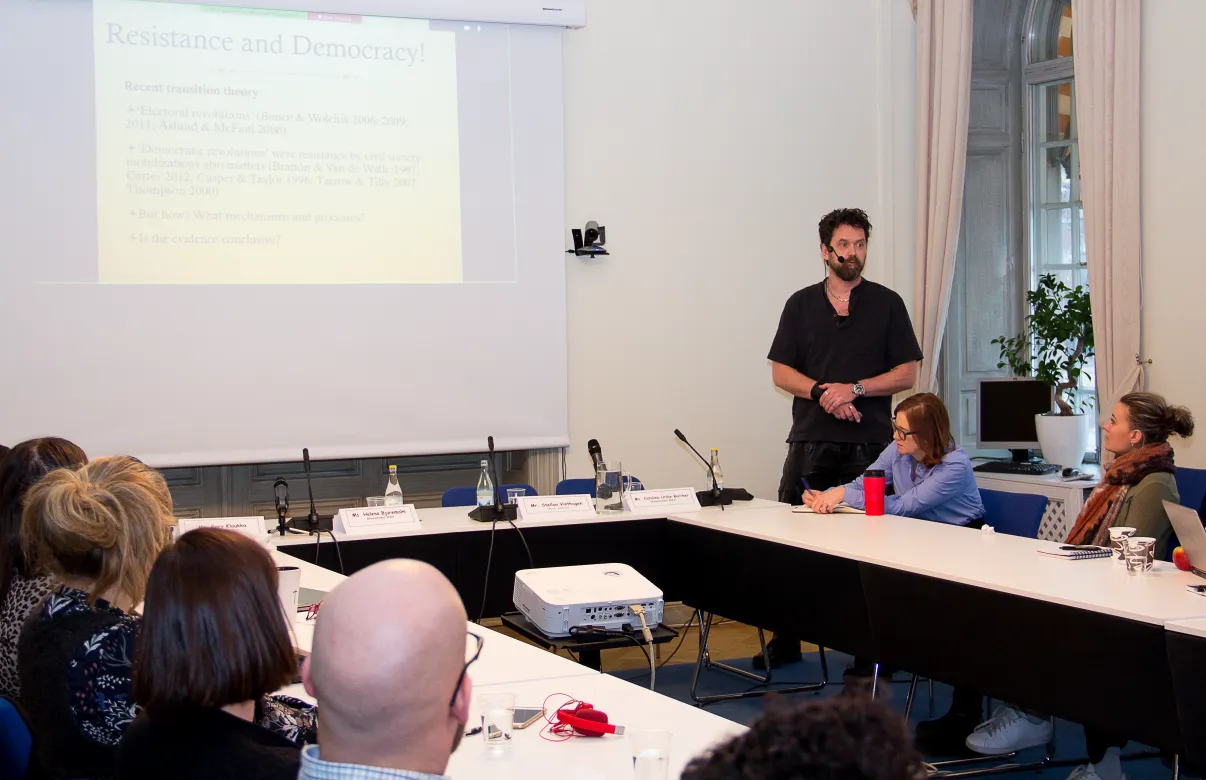The relationship between democratisation and resistance

Stellan Vinthagen, the Endowed Chair in the Study of Nonviolent Direct Action and Civil Resistance at University of Massachusetts, Amherst, the United States of America, gave a talk at International IDEA about the relationship between democratisation and resistance, on 24 January 2017, co-hosted by International IDEA and the Swedish Development Forum (Föreningen för Utvecklingsfrågor, FUF).
Vinthagen’s presentation focused on questions such as what are the contributions and the weaknesses of unarmed popular resistance movements in relation to democratisation. How can party politics and non-violent resistance be combined in order to strengthen democratisation, both in liberal democracies and autocracies?
He argued that we need to rethink the relationship between resistance and democratisation in order to understand what is going on with ordinary people in peaceful protest that brings down dictators and that there is a connection between popular mobilisation of unarmed resistance and democratisation, but it varies in the different contexts of liberal democracies, hybrid democracies, and autocracies and other variables like strategies, training, and dynamics.
Vinthagen looked at revolutionary resistance movements – both violent and non-violent – and presented data on how often they bring about sustainable, long-term democracies. He cited research by Erica Chenoweth which indicated that unarmed resistance campaigns tended to be more successful than armed ones, and more often the unarmed campaigns resulted in democracy and peace.
A tentative thesis is that unarmed resistance campaigns are succeeding because they are more able to mobilise mass movements and divide regimes, but the evidence is inconclusive. Ethnic polarisation makes it more difficult while as having democratic neighbors makes success more likely.
The success of resistance movements may be affected by a large number of variables, including repression, parallel institutions, regime type, violence and the broader context. The higher the number of people participating in a campaign, the more successful it will be. If 3.5 per cent of the population joins a campaign – it is bound to succeed in overthrowing the autocratic regime. However, unarmed resistance is getting less effective. Around 2005 the curve turned into a clear drop in the success rate.
The broader issues revolve around resistance movements succeeding in forming national governments. Some of them struggle with staying true to their original ideologies and in creating a stable democracy. These movements tend to not really be prepared to take over a state-apparatus. Most or all of them are very soon implementing neo-liberal economic policies in ways that do not promote equality and deeper levels democratisation. Even successful unarmed revolutions have problems to create more than only formal democracy. Citizen movements that turn into political parties face similar challenges.
Vinthagen highlighted that some regimes have adapted by deploying counterstrategies to thwart resistance movements, for example by using violent repression and restricting access to the Internet. Regimes use classical methods of oppression but increasingly non-traditional methods such as release of criminals, creating youth movements who protest in the streets in support of the government, encourage sectarian conflicts, temporary closure of social media, and even moving the national capital.
The presentation was followed by a panel discussion with Catalina Uribe Burcher and Gary Klaukka, moderated by Helena Bjuremalm, all staff at International IDEA. The event was attended by close to fifty participants including representatives of academia, Right Livelihood Award, and the Swedish Fellowship of Reconciliation.




